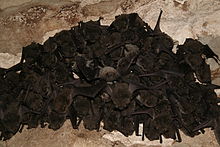Gray mouse ear
| Gray mouse ear | ||||||||||||
|---|---|---|---|---|---|---|---|---|---|---|---|---|

Gray mouse-eared mouse ( Myotis grisescens ) |
||||||||||||
| Systematics | ||||||||||||
|
||||||||||||
| Scientific name | ||||||||||||
| Myotis grisescens | ||||||||||||
| Howell , 1909 |
The gray mouse- eared bat ( Myotis grisescens ) is a bat species from the smooth-nosed family (Vespertilionidae), which is native to North America. The Latin species name refers to the coat color ( griseus = 'gray').
description
The gray mouse-eared ear is one of the largest representatives of this genus in North America with an average head-to-trunk length of 49.8 mm, a forearm length of 43.4 mm and a weight of 7.9 to 13.5 g. The gray mouse- eared ear can most likely be confused with Myotis lucifugus , M. sodalis , M. austroriparius and M. septentrionalis . However, it can be distinguished from the other species by the uniformly gray fur, as well as the fact that the flight membrane begins at the ankle instead of the base of the toes and the claws of the toes have a notch.
Way of life
Like most bats, the gray mouse-eared mouse is nocturnal and feeds on insects. It is estimated that a colony of 250,000 animals wipes out over a ton of insects every night. The preferred prey animals include beetles , two-winged birds , butterflies , caddis flies and constant- winged flies , although beaked peckers and mayflies are occasionally eaten. When hunting, the animals produce frequency-modulated echolocation calls with a frequency of 45 to 100 kHz, which are inaudible to humans. However, just before catching an insect, the frequency can drop as much as 15 kHz. While foraging, the animals cover up to 52 km, at an average flight speed of 20.3 km / h and a top speed of 39 km / h. During the summer, the animals hang in caves during the day with temperatures between 13.9 and 26.3 ° C and a high humidity of 86 to 99%. The animals can reach a density of over 1,800 individuals per square meter. By winter, gray mouse-ears double their weight, with the body mass just before hibernation consisting of up to 25% of fat reserves. The gray mouse-eared mouse prefers particularly cold caves for hibernation. Although there are many caves in their area that are used as sleeping places in summer, less than 0.1% are suitable for wintering. To get to such caves, the gray mouse-eared mouse migrates up to 775 km in autumn.
Well-known predators include owls like the Eastern Screech Owl ( Otus asio ) and snakes like the peanut snake ( Pantherophis obsoletus ). The oldest known gray mouse-eared mouse was 16.5 years old.
Reproduction
Gray mouse ears mate in autumn, with the females storing the sperm . The ovulation takes place only in the spring from March to April, after which the egg is fertilized by the stored sperm. The females give birth to a single young between May and June, whereby they can form large colonies consisting of over 250,000 individuals. The newborn is born hairless and with closed eyes and weighs an average of 2.9 g. During the suckling period, the young will gain between 0.17 and 0.22 g per day. The warmer the caves, the faster the young will grow. They make their first flight attempts at the age of 24 to 33 days.
Hazard and protection
The IUCN assesses their existence as potentially endangered. In this regard, the IUCN is based on assessments by the United States Fish and Wildlife Service , according to which the populations fell by half between 1960 and 1980. In Missouri in 1994 only 26 of the original 66 winter caves were occupied. The commercial use of the caves in which the animals hibernate or raise their young probably already became a problem for the gray mouse- eared mouse during the Civil War , when bat guano was mined in the caves for the extraction of saltpetre . About 95% of the known population hibernates in eight or nine caves today, with half hibernating in a single cave (the Fern Cave in Alabama ). 90% of these caves, as well as many caves that are used by mother animals during the rearing of the young, are now protected. The IUCN estimates that the populations are recovering, but it is pointed out that in addition to the destruction of the habitat, the use of insecticides could further endanger the populations. Research has shown that the concentration of dieldrin in breast milk of the gray mouse-eared mouse can be up to 30 times higher than that of prey insects, and there is evidence from Missouri and Alabama that gray mouse-ears died of dieldrin poisoning. The use of this insecticide has been banned in the United States since 1974, but has been replaced by other toxic pesticides.
distribution and habitat
The gray mouse-eared mouse is found in the United States . Their distribution area extends in the west to Missouri , in the east to Virginia, in the north to Illinois , Indiana and Ohio , in the south to the Gulf of Mexico .
literature
- J. Decher, JR Choate (1995): Myotis grisescens. In: Mammalian Species , No. 510, pp. 1-7.

